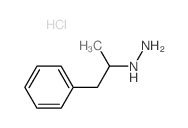CHEMICAL IDENTIFICATION
-
RTECS NUMBER :
-
MV7400000
-
CHEMICAL NAME :
-
Hydrazine, (alpha-methylphenethyl)-, monohydrochloride
-
CAS REGISTRY NUMBER :
-
66-05-7
-
LAST UPDATED :
-
199206
-
DATA ITEMS CITED :
-
5
-
MOLECULAR FORMULA :
-
C9-H14-N2.Cl-H
-
MOLECULAR WEIGHT :
-
186.71
-
WISWESSER LINE NOTATION :
-
ZM1Y1&R &GH
HEALTH HAZARD DATA
ACUTE TOXICITY DATA
-
TYPE OF TEST :
-
LD50 - Lethal dose, 50 percent kill
-
ROUTE OF EXPOSURE :
-
Intraperitoneal
-
SPECIES OBSERVED :
-
Rodent - rat
-
DOSE/DURATION :
-
180 mg/kg
-
TOXIC EFFECTS :
-
Details of toxic effects not reported other than lethal dose value
-
REFERENCE :
-
ABMGAJ Acta Biologica et Medica Germanica. (Berlin, Ger. Dem. Rep.) V.1-41, 1958-82. For publisher information, see BBIADT. Volume(issue)/page/year: 18,617,1967
-
TYPE OF TEST :
-
LD50 - Lethal dose, 50 percent kill
-
ROUTE OF EXPOSURE :
-
Oral
-
SPECIES OBSERVED :
-
Rodent - mouse
-
DOSE/DURATION :
-
59 mg/kg
-
TOXIC EFFECTS :
-
Details of toxic effects not reported other than lethal dose value
-
REFERENCE :
-
IJNEAQ International Journal of Neuropharmacology. (New York, NY) V.1-8, 1962-69. For publisher information, see NEPHBW. Volume(issue)/page/year: 5,125,1966
-
TYPE OF TEST :
-
LD50 - Lethal dose, 50 percent kill
-
ROUTE OF EXPOSURE :
-
Intraperitoneal
-
SPECIES OBSERVED :
-
Rodent - mouse
-
DOSE/DURATION :
-
112 mg/kg
-
TOXIC EFFECTS :
-
Behavioral - changes in motor activity (specific assay)
-
REFERENCE :
-
JMCMAR Journal of Medicinal Chemistry. (American Chemical Soc., Distribution Office Dept. 223, POB POB 57136, West End Stn., Washington, DC 20037) V.6- 1963- Volume(issue)/page/year: 18,20,1975
-
TYPE OF TEST :
-
LD50 - Lethal dose, 50 percent kill
-
ROUTE OF EXPOSURE :
-
Subcutaneous
-
SPECIES OBSERVED :
-
Rodent - mouse
-
DOSE/DURATION :
-
87 mg/kg
-
TOXIC EFFECTS :
-
Details of toxic effects not reported other than lethal dose value
-
REFERENCE :
-
IJNEAQ International Journal of Neuropharmacology. (New York, NY) V.1-8, 1962-69. For publisher information, see NEPHBW. Volume(issue)/page/year: 5,125,1966
-
TYPE OF TEST :
-
LD50 - Lethal dose, 50 percent kill
-
ROUTE OF EXPOSURE :
-
Intravenous
-
SPECIES OBSERVED :
-
Rodent - mouse
-
DOSE/DURATION :
-
66 mg/kg
-
TOXIC EFFECTS :
-
Details of toxic effects not reported other than lethal dose value
-
REFERENCE :
-
IJNEAQ International Journal of Neuropharmacology. (New York, NY) V.1-8, 1962-69. For publisher information, see NEPHBW. Volume(issue)/page/year: 5,125,1966
|
